
The Ministry of Culture Denmark (Danish: Kulturministeriet) is a ministry of the Danish Government, with responsibility for culture, sport and media.

The Ministry of Culture Denmark (Danish: Kulturministeriet) is a ministry of the Danish Government, with responsibility for culture, sport and media.
The Ministry is located at Gammel Strand on Nybrogade opposite Slotsholmen. Originally, it was a three-winged building. Its construction started in 1729. In 1765, it was expanded with the complex with a new wing facing the canal which was designed was added by architect Philip de Lange (c. 1705-1766). The building served from 1759 to c. 1950 as site of the Royal Pawn (Det Kongelige Assistenshus). [1]
The Danish Ministry of Culture was founded in 1961 with Julius Bomholt as its first minister. [2] In 1962, the ministry moved in after the building had undergone a thorough restoration. [3] [4]

Charlottenborg Palace is a large town mansion located on the corner of Kongens Nytorv and Nyhavn in Copenhagen, Denmark. Originally built as a residence for Ulrik Frederik Gyldenløve, it has served as the base of the Royal Danish Academy of Fine Arts since its foundation in 1754. Today it also houses Kunsthal Charlottenborg, an institution for contemporary art, and Danmarks Kunstbibliotek, the Royal Art Library.

The Royal Danish Academy of Fine Arts, School of Design, more commonly known as the Danish Design School is an institution of higher education in Copenhagen, Denmark, offering a five-year design education consisting of a three-year Bachelor programme and a two-year Master in design as well as conducting research within the fields of arts, crafts and design. Danmarks Designskole is an institution under the Ministry of Science, Innovation and Higher Education.

Gammel Strand is a street and public square in central Copenhagen, Denmark. On the south side it borders on the narrow Slotsholmens Canal while the north side is lined by a row of brightly coloured houses from the 18th and 19th century. Across the canal, Thorvaldsens Museum and Christiansborg Palace are seen on the island Slotsholmen.

Glorup is a manor house located between Nyborg and Svendborg in the south-east of the Danish island Funen. Rebuilt to the design of Nicolas-Henri Jardin and his pupil Christian Josef Zuber in 1763–65, it is considered one of the finest Baroque complexes in Denmark and was included in the 2006 Danish Culture Canon.
Philip de Lange was a leading Dutch-Danish architect who designed many different types of building in various styles including Dutch Baroque and Rococo.

Gl. Holtegaard is a former Manor house in Rudersdal Municipality north of Copenhagen, Denmark, today operated as an arts centre and a museum. It was built by the Danish Baroque architect Lauritz de Thurah (1706–1759), for his own use in 1757. Its original Baroque gardens were reconstructed in 2003.

The Aarhus School of Architecture was founded in 1965 in Aarhus, Denmark. Along with the Royal Danish Academy of Fine Arts, School of Architecture in Copenhagen, it is responsible for the education of architects in Denmark. The school has approximately 750 students.
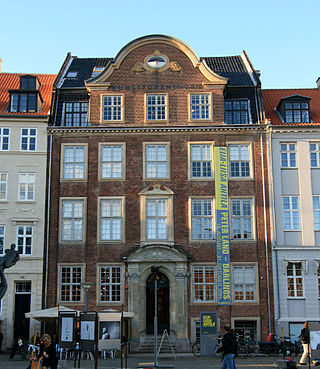
Kunstforeningen, now officially called Gammel Strand after its address, is an exhibition space and non-profit membership organization located at Gammel Strand in Copenhagen, Denmark. It was founded in 1825 to promote and support art through public exhibitions, lectures, acquisitions of art works for distribution among the members, support of artists and publications on art.
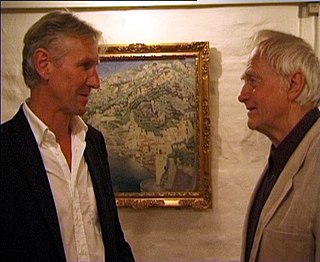
Ib Spang Olsen was a Danish writer and illustrator best known to generations of Danes for cartoons and illustrations, many of which appeared in children's publications. Those include a series of nursery rhyme books written by Halfdan Rasmussen, including "Halfdans ABC". He also wrote his own children's books, such as the whimsical tale of the seasons, The Marsh Crone's Brew. Olsen drew for newspapers, magazines, books, posters, television, and comics. For his lasting contribution as a children's illustrator Olsen received the international Hans Christian Andersen Medal in 1972.

Gammel Køgegård is a manor house located just west of Køge, Denmark.
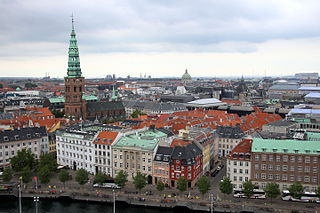
Ved Stranden is a canal side public space and street which runs along a short section of the Zealand side of Slotsholmen Canal in central Copenhagen, Denmark. It begins at Holmens Kanal, opposite the Church of Holmen, and runs west along the canal for one and a half blocks before widening into a small, triangular space adjacent to Højbro Bridge and Højbro Plads. The name of the street refers to Gammel Strand, 'Old Beach', which it formed part of until 1961.
The Danish Arts Foundation is the principal Danish government funded arts foundation founded by a special Law on 27 May 1964.

Alf Cock-Clausen was a Danish architect. He was active during the transition from Neoclassicism to Functionalism and many of his works show influence from Art Deco. His factory for the distillery De Danske Spritfabrikker at Aalborg's harbour front was declared a Danish Industrial Heritage Site in 2009.
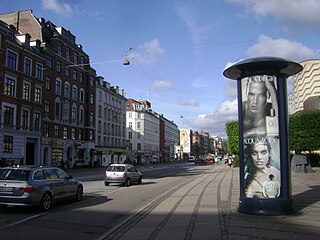
Gammel Kongevej is the principal shopping street of Frederiksberg in Copenhagen, Denmark. Running roughly parallel to Frederiksberg Allé and Vesterbrogade, it extends from Vesterport station at the southern end of The Lakes and continues for some 1.8 km west to Frederiksberg City Hall Square where it continues as Smallegade. In the opposite end, Jernbanegade connects it to Copenhagen City Hall Square.

Møinichen Mansion is a town mansion Købmagergade in central Copenhagen, Denmark. It later served as headquarters of Royal Danish Mail from 1779 until 1912 and was known as the Royal Mail House. Købmagergade Post Office, was located in the building until June 2015 while the Post & Rele Museum was located on the two upper floors from 1907 until 2015. The building was acquired by the PFA pension fund in December 2014 and is in use for both retail and offices.

N. Zahle's School is a private school located on Nørre Voldgade in Copenhagen, Denmark. Named after its founder, Natalie Zahle (1827–1913), it now consists of two independently run primary schools and a Gymnasium.
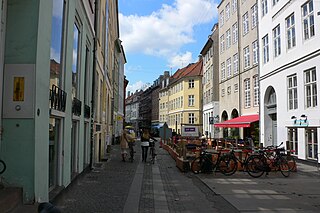
Strædet is the colloquial name of a popular shopping and café street in the Old Town of Copenhagen, Denmark, linking Højbro Plads on Strøget at its eastern end with Regnbuepladsen next to City Hall to the west. The official street names are Læderstræde, Kompagnistræde and Farvergade. The shops along the street are generally smaller and more eclectic than the flagship stores on neighbouring Strøget. It is dominated by art galleries and antique shops. It is known for its rich gay culture with LGBT citizens, shops, bars, restaurants and coffeehouses.
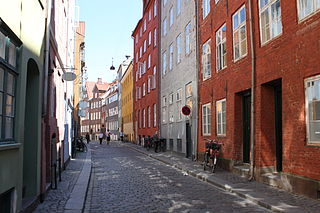
Snaregade and Magstræde are two of the oldest streets in the Old Town of Copenhagen, Denmark, linking Gammel Strand at their eastern end with Rådhusstræde to the west. Snaregade extends from the small square at the Gammel Strand metro station to Knabrostræde where it turns into Magstræde. The streets are among the few streets in the Old Town of Copenhagen which still feature their original cobbling. Magstræde is associated with Huset i Magstræde, now officially referred to as Huset KBH, a culture house.
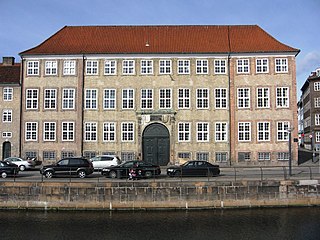
The Royal Pawn was a pawnbroking establishment which existed from 1688 to 1975 in Copenhagen, Denmark. It was created at private initiative but was taken over by the state in 1758. Its former building at Nybrogade 2 was expanded by Philip de Lange in 1762. It is now home to the Ministry of Culture. The building was listed on the Danish registry of protected buildings and places in 1918.
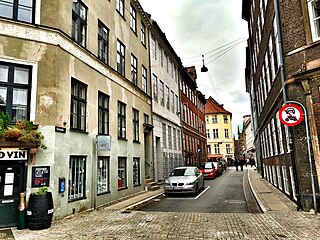
Naboløs is a short street in the Old Town of Copenhagen, Denmark. All six properties in the street date from the rebuilding of the city in the years after the Copenhagen Fire of 1795 and have been added to the Danish registry of protected buildings and places. Together with Hyskenstræde it provides a direct link between the shopping street Strøget and the metro station at Gammel Strand.